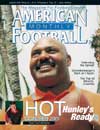AMERICAN FOOTBALL MONTHLY THE #1 RESOURCE FOR FOOTBALL COACHES
Article CategoriesAFM Magazine
|
Option for the new Milleniumby: Ron FinleyHead Coach, Campbellsville University © More from this issue We came to Campbellsville in May of 1987 to start a new football program and played a JV schedule that first season. In our first varsity season (1988), we did not win a game. However, since the season of 1989, we have had a record of 57 wins, 57 losses and 1 tie, plus 2 Mid-South Conference Championships (1992 and 1997) and one trip to the NAIA national playoffs. We have attained a ranking as high as second in the nation as a team, and had several top 10 rankings in team offense and team defense. Our offense at Campbellsville has grown from pure option and play-action pass out of the wishbone formation to a Pro-I and Slot-I formation. We have retained the option running attack and play-action passes that keep defenses honest. In the ³I² formations we have featured the sprint-out pass, which also is a form of option since you either....The full article can only be seen by subscribers.
|
|
|||||||
| HOME |
MAGAZINE |
SUBSCRIBE | ONLINE COLUMNISTS | COACHING VIDEOS |
Copyright 2025, AmericanFootballMonthly.com
All Rights Reserved





